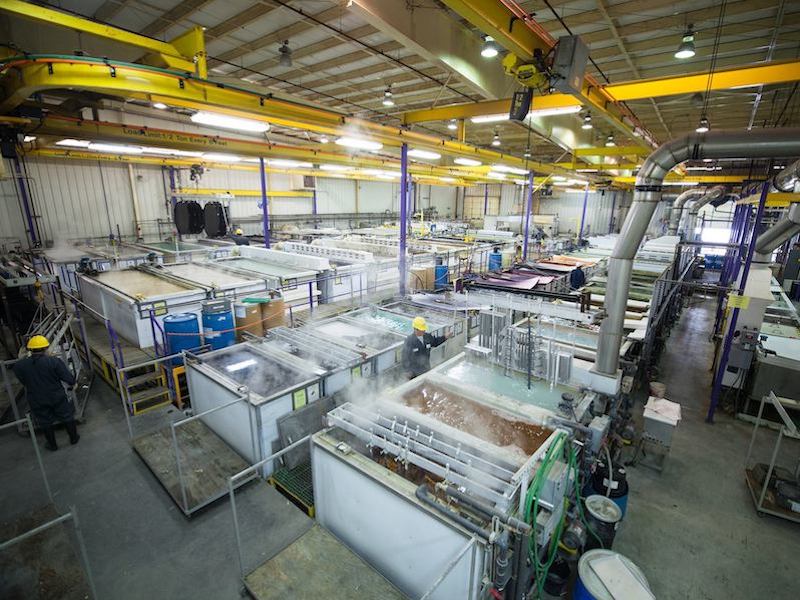The U.S. Environmental Protection Agency and the Michigan Department of Environment, Great Lakes, and Energy (EGLE) has completed a study of 11 surface finishing plants in the state and determined that suppressants used to reduce perfluorooctane sulfonic acid (PFOS) were, in fact, PFOS-free.
Further, the results of the study found that none of these replacement products contained “PFOS precursors, which are specific longer-chain per- and polyfluoroalkyl substances (PFAS) that could break down into PFOS.”
“In the targeted analysis, only one PFAS compound, 6:2 fluorotelomer sulfonates (FTS), was found in the currently used fume suppressants,” the report states. “Current discharges of PFOS are, therefore, assumed to be associated with historical use of PFOS-containing products.”
The report is entitled “Targeted and Nontargeted Analysis of PFAS in Fume Suppressant Products at Chrome Plating Facilities,” and can be downloaded here.
The study was conducted with samples obtained in July 2019 of nine different fume suppressants and effluent from the 11 Michigan platers. Final reports of the analysis were received from the USEPA late February 2020.
EGLE is holding a webinar to discuss the report on July 9 at 10 a.m. Register by clicking here.
The following is taken from the EGLE report:
Beginning in 2017, EGLE found unexpectedly high levels of PFOS in chrome plating wastewater (i.e., effluent), which is generally routed to wastewater treatment plants (WWTP) for treatment along with municipal sanitary wastewater before discharge to lakes and streams. In 2018, EGLE asked the U.S. EPA’s Office of Research and Development (ORD) to conduct a study to answer the question of whether the PFOS-free fume suppressants (also called mist suppressants or surfactants) are really PFOS-free and/or if PFOS concentrations were being generated within the harsh environment of the plating process from the breakdown of long-chain precursors in the replacement products.
EGLE and the USEPA conducted the study to assist in compliance efforts undertaken by the chrome plating industry in Michigan, where many platers have had to invest significant resources to install pretreatment systems to remove PFOS from their process wastewater even though they complied with federal requirements to discontinue use of the PFOS-based fume suppressants years prior.
Fume suppressants are commonly used by electroplating facilities for controlling air emissions and reducing worker exposure to hexavalent chromium, a known human carcinogen and inhalation hazard. The USEPA required chrome platers to stop using PFOS-containing fume suppressants in chrome plating tanks in September 2015 due to concerns about human health and environmental impacts.
Through a statewide initiative, EGLE's Water Resources Division found that some electroplaters who stopped using PFOS-containing fume suppressants years ago were still discharging PFOS to sanitary sewers in concentrations that resulted in municipal WWTPs exceeding state water quality standards. These exceedances continued even after extensive cleaning and disposal efforts.
 Concurrently, EGLE's Air Quality Division conducted inspections at several chrome platers in Michigan and found that PFOS-based fume suppressants were no longer in use at these facilities and they had switched to "PFOS-free" replacement products. Federal regulations define "PFOS-free" fume suppressants as containing less than one percent PFOS by weight. EGLE was concerned that PFOS may still be present in the replacement products at levels that met the federal definition but would still exceed the very low screening concentrations, which are measured in ppt.
Concurrently, EGLE's Air Quality Division conducted inspections at several chrome platers in Michigan and found that PFOS-based fume suppressants were no longer in use at these facilities and they had switched to "PFOS-free" replacement products. Federal regulations define "PFOS-free" fume suppressants as containing less than one percent PFOS by weight. EGLE was concerned that PFOS may still be present in the replacement products at levels that met the federal definition but would still exceed the very low screening concentrations, which are measured in ppt.
In addition, many of these PFOS-free replacement products are still based on PFAS compounds, and EGLE questioned whether potential long-chain precursors in the replacement products could be converting to PFOS within the harsh environment of the plating process. To answer these questions, EGLE asked the USEPA's ORD to conduct a study to investigate whether the "PFOS-free" fume suppressants are really PFOS-free and/or if PFOS is being generated within the harsh environment of the plating process from the breakdown of long-chain precursors in the replacement products.
EGLE and the USEPA conducted this study to assist in compliance efforts undertaken by the chrome plating industry. A number of platers in Michigan have had to invest significant resources to install pretreatment systems to remove PFOS from their process wastewater, conduct cleaning, and replace equipment. For the study, EGLE worked with 11 chrome platers across the state to sample fume suppressant products and process wastewater (after pretreatment for metals and pH but prior to any pretreatment for PFOS and before discharge to the municipal sanitary sewer). These chrome platers agreed to participate in the study on a voluntary basis to provide valuable information to the plating industry. The USEPA provided its analytical expertise to identify and quantify PFAS, both legacy and novel, in fume suppressants and effluent.


































